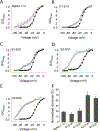Charge substitutions at the voltage-sensing module of domain III enhance actions of site-3 and site-4 toxins on an insect sodium channel
- PMID: 34358664
- PMCID: PMC9376739
- DOI: 10.1016/j.ibmb.2021.103625
Charge substitutions at the voltage-sensing module of domain III enhance actions of site-3 and site-4 toxins on an insect sodium channel
Abstract
Scorpion α-toxins bind at the pharmacologically-defined site-3 on the sodium channel and inhibit channel inactivation by preventing the outward movement of the voltage sensor in domain IV (IVS4), whereas scorpion β-toxins bind at site-4 on the sodium channel and enhance channel activation by trapping the voltage sensor of domain II (IIS4) in its outward position. However, limited information is available on the role of the voltage-sensing modules (VSM, comprising S1-S4) of domains I and III in toxin actions. We have previously shown that charge reversing substitutions of the innermost positively-charged residues in IIIS4 (R4E, R5E) increase the activity of an insect-selective site-4 scorpion toxin, Lqh-dprIT3-c, on BgNav1-1a, a cockroach sodium channel. Here we show that substitutions R4E and R5E in IIIS4 also increase the activity of two site-3 toxins, LqhαIT from Leiurusquinquestriatus hebraeus and insect-selective Av3 from Anemonia viridis. Furthermore, charge reversal of either of two conserved negatively-charged residues, D1K and E2K, in IIIS2 also increase the action of the site-3 and site-4 toxins. Homology modeling suggests that S2-D1 and S2-E2 interact with S4-R4 and S4-R5 in the VSM of domain III (III-VSM), respectively, in the activated state of the channel. However, charge swapping between S2-D1 and S4-R4 had no compensatory effects on gating or toxin actions, suggesting that charged residue interactions are complex. Collectively, our results highlight the involvement of III-VSM in the actions of both site 3 and site 4 toxins, suggesting that charge reversing substitutions in III-VSM allosterically facilitate IIS4 or IVS4 voltage sensor trapping by these toxins.
Keywords: Electrophysiology; Homology modeling; Insect sodium channel; Mutagenesis; Scorpion α-toxin; Scorpion β-toxin.
Copyright © 2021 Elsevier Ltd. All rights reserved.
Conflict of interest statement
Declaration of competing interest
The authors declare that they have no conflicts of interest with the contents of this article.
Figures





Comment in
-
Allosteric interactions among voltage-sensor modules of sodium channels probed by scorpion toxin modifiers.J Neurobiol Physiol. 2022;4(1):9-12. doi: 10.46439/neurobiology.4.021. J Neurobiol Physiol. 2022. PMID: 37034138 Free PMC article.
Similar articles
-
Substitutions in the domain III voltage-sensing module enhance the sensitivity of an insect sodium channel to a scorpion beta-toxin.J Biol Chem. 2011 May 6;286(18):15781-8. doi: 10.1074/jbc.M110.217000. Epub 2011 Mar 15. J Biol Chem. 2011. PMID: 21454658 Free PMC article.
-
Mapping the interaction surface of scorpion β-toxins with an insect sodium channel.Biochem J. 2021 Jul 30;478(14):2843-2869. doi: 10.1042/BCJ20210336. Biochem J. 2021. PMID: 34195804 Free PMC article.
-
NMR analysis of interaction of LqhalphaIT scorpion toxin with a peptide corresponding to the D4/S3-S4 loop of insect para voltage-gated sodium channel.Biochemistry. 2008 Jan 22;47(3):911-21. doi: 10.1021/bi701323k. Epub 2007 Dec 23. Biochemistry. 2008. PMID: 18154318
-
Site-3 toxins and cardiac sodium channels.Toxicon. 2007 Feb;49(2):181-93. doi: 10.1016/j.toxicon.2006.09.017. Epub 2006 Sep 27. Toxicon. 2007. PMID: 17092528 Free PMC article. Review.
-
Molecular mechanisms of gating and drug block of sodium channels.Novartis Found Symp. 2002;241:206-18; discussion 218-32. Novartis Found Symp. 2002. PMID: 11771647 Review.
Cited by
-
The Sea Anemone Neurotoxins Modulating Sodium Channels: An Insight at Structure and Functional Activity after Four Decades of Investigation.Toxins (Basel). 2022 Dec 21;15(1):8. doi: 10.3390/toxins15010008. Toxins (Basel). 2022. PMID: 36668828 Free PMC article. Review.
-
Allosteric interactions among voltage-sensor modules of sodium channels probed by scorpion toxin modifiers.J Neurobiol Physiol. 2022;4(1):9-12. doi: 10.46439/neurobiology.4.021. J Neurobiol Physiol. 2022. PMID: 37034138 Free PMC article.
References
-
- Armstrong CM, 1981. Sodium channels and gating currents. Physiol. Rev 61, 644–683. - PubMed
-
- Catterall WA, 1992. Cellular and molecular biology of voltage-gated sodium channels. Physiol. Rev 72, S15–S48. - PubMed
-
- Catterall WA, 2000. From ionic currents to molecular mechanisms: the structure and function of voltage-gated sodium channels. Neuron 26, 13–25. - PubMed
-
- Catterall WA, Cestele S, Yarov-Yarovoy V, Yu FH, Konoki K, Scheuer T, 2007. Voltage-gated ion channels and gating modifier toxins. Toxicon 49, 124–141. - PubMed
Publication types
MeSH terms
Substances
Grants and funding
LinkOut - more resources
Full Text Sources

